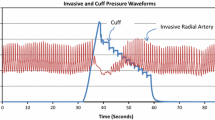Abstract
It is well recognized that catheter-manometer systems significantly distort direct radial artery pressure measurements. Sinusoidal frequency analysis and the flush method of assessing the degree of distortion caused by the monitoring system were compared to determine whether these two methods agree in the estimation of natural frequency and damping coefficient. The frequency response of 30 radial artery catheter-manometer systems used for intensive-care unit patients was measured by the flush method and sinusoidal frequency analysis. The monitoring system consisted of a 20-gauge cannula, 150-cm pressure tubing, two plastic stopcocks, a continuous infusion device with fast flush valve, an American Edwards dome, a Hewlett-Packard quartz transducer, and a Hewlett-Packard blood pressure amplifier. Sinusoidal frequency analysis demonstrated second-order underdamped response for all 30 catheter-manometer systems. No secondary resonance peaks were observed up to a frequency of 200 Hz. The measured frequency response demonstrated that the average catheter-manometer system in use in our intensive care unit would cause significant distortion of the radial artery pressure, with the mean natural frequency (fn) of 14.7 ± 3.7 Hz and the mean damping coefficient (ζ) of 0.24 ± 0.07. Although the 30 monitoring systems had identical configurations and visible bubbles were carefully removed, a wide range of frequency responses was found (fn=10.2 to 25.3; ζ=0.15 to 0.44). Linear regression analysis demonstrated excellent correlation (r=0.96) for the natural frequency measured by the flush method and sinusoidal frequency analysis. Linear regression for the damping coefficient, on the other hand, demonstrated poor correlation (r=−0.24) for the two measurement methods. Four of the 30 catheter-manometer systems exhibited overdamped behavior by the flush method; sinusoidal frequency analysis demonstrated an underdamped response. The difference in damping coefficient measurements between the two techniques occurs because sinusoidal frequency analysis does not include the effect of the cannula within the radial artery. Because of the position of the tip, this effect can significantly influence the damping coefficient. Since there is a wide variation in responses for debubbled identical systems, it is necessary to test each individual monitoring system used to determine its frequency response. The flush method is more reliable than sinusoidal frequency analysis since it includes the effect of the intraarterial cannula.
Similar content being viewed by others
References
Fry DL. Physiologic recording by modern instruments with particular reference to pressure recording. Physiol Rev 1960;40:753–788
Gabe IT. Pressure measurement in experimental physiology. In: Bergel EH, ed. Cardiovascular fluid dynamics, Vol. 1. London: Academic Press, 1972:11–50
Yanof HM, Rosen AL, McDonald NM, McDonald DA. A critical study of the response of manometers to forced oscillations. Phys Med Biol 1963;8:407–422
Shapiro GG, Krovetz LJ. Damped and undamped frequency responses of underdamped catheter manometer systems. Am Heart J 1970;80:226–236
McCutcheon EP, Evans JM, Stanifer RR. Direct blood-pressure measurement: gadgets versus progress. Anesth Analg 1972;5:746–758
Fry DL, Noble FW, Mallos AJ. An evaluation of modern pressure recording systems. Circ Res 1957;5:40–46
Attinger EO. Pulsatile blood flow. New York: McGraw-Hill, 1964:437–438
Melbin J, Spohr M. Evaluation and correction of manometer systems with two degrees of freedom. J Appl Physiol 1969;27:749–755
Gardner RM. Direct blood pressure measurement—dynamic response requirements. Anesthesiology 1981;54:227–236
Levasseur JE, Funk FC, Patterson JL, Jr. Square-wave liquid pressure generator for testing blood pressure transducers. J Appl Physiol 1969;27:426–430
Shinozaki T, Deane RS, Mazuzan JE. The dynamic responses of liquid-filled catheter systems for direct measurements of blood pressure. Anesthesiology 1980;53:498–504
Hughes VG, Prys-Roberts C. Intra-arterial pressure measurements. A review and analysis of methods relevant to anaesthesia and intensive care. Anaesthesia 1971;26:511–512
Taylor BC, Ellis DM, Drew JM. Quantification and simulation of fluid-filled catheter/transducer systems. Med Instrum 1986;20:123–129
Author information
Authors and Affiliations
Rights and permissions
About this article
Cite this article
Schwid, H.A. Frequency response evaluation of radial artery catheter-manometer systems: Sinusoidal frequency analysis versus flush method. J Clin Monitor Comput 4, 181–185 (1988). https://doi.org/10.1007/BF01621814
Received:
Revised:
Accepted:
Issue Date:
DOI: https://doi.org/10.1007/BF01621814




